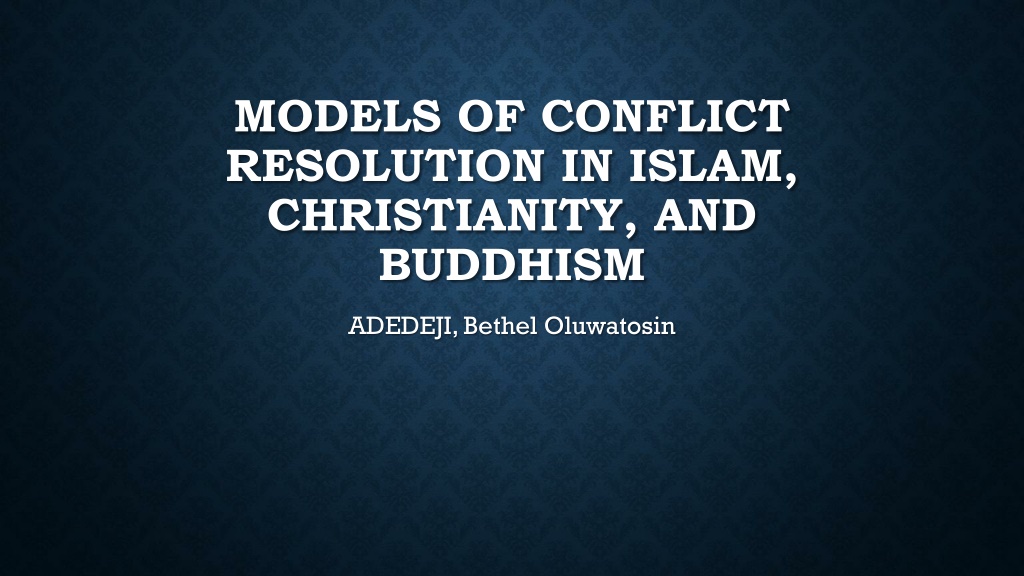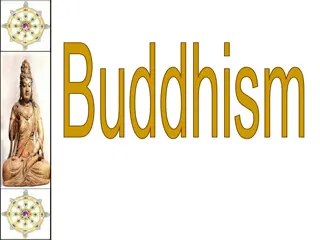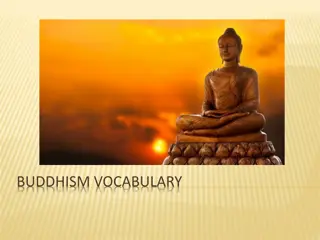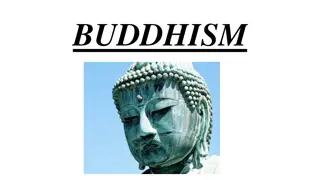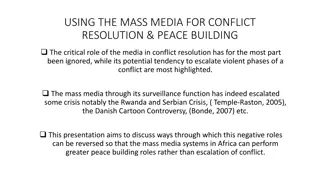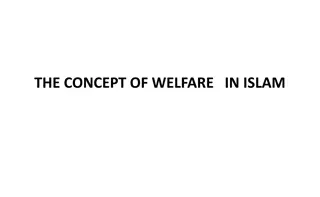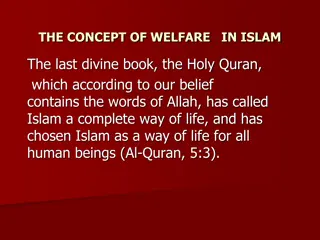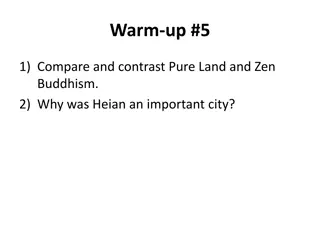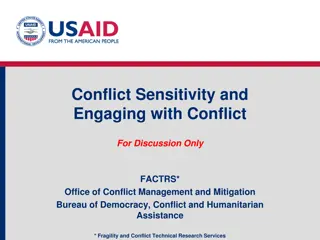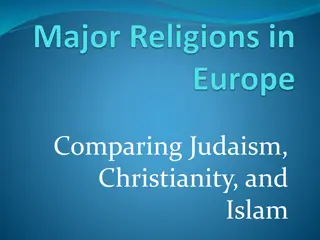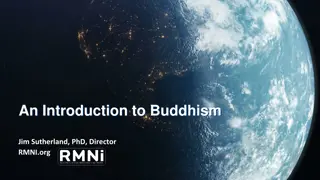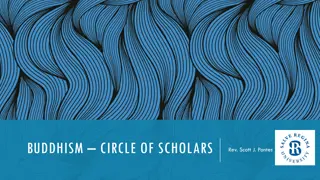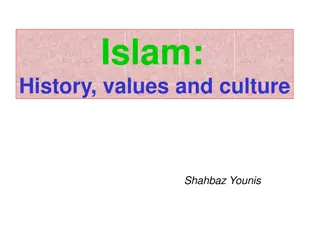Models of Conflict Resolution in Islam, Christianity, and Buddhism
Conflict resolution is essential for peaceful solutions in disagreements. This discourse explores models of conflict resolution in Islam, Christianity, and Buddhism, emphasizing the importance of dialogue, good intentions, and reconciliation across diverse beliefs and cultures.
Download Presentation

Please find below an Image/Link to download the presentation.
The content on the website is provided AS IS for your information and personal use only. It may not be sold, licensed, or shared on other websites without obtaining consent from the author. Download presentation by click this link. If you encounter any issues during the download, it is possible that the publisher has removed the file from their server.
E N D
Presentation Transcript
MODELS OF CONFLICT RESOLUTION IN ISLAM, CHRISTIANITY, AND BUDDHISM ADEDEJI, Bethel Oluwatosin
OVERVIEW Models of Conflict in Islam Models of Conflict Resolution in Christianity Models of Conflict Resolution in Buddhism
INTRODUCTION Conflict resolution is a way for two or more parties to find a peaceful solution to a disagreement among them. The disagreement may be personal, financial, political, or emotional. When a dispute arises, often the best course of action is negotiation to resolve the disagreement. Religion is synonymous with peace. There are misconceptions of religion as the major cause of conflict in the society today. Embedded in several religious text are models for conflict resolution. For this discourse, three major religions will be examined namely; Islam, Christianity, and Buddhism.
MODELS OF CONFLICT RESLOLUTION IN ISLAM Islam literally means two basic concepts: First, Islam from the Arabic verb salima/yaslemu means to surrender or submit to God. And second, from its Arabic noun salam - from letters seen, lam, meem (or s, l, m) - it means peace or to acquire peace. A daily example of this is provided by Muslims in their greetings of Assalamu Alaykum, meaning peace be with you.
MODELS OF CONFLICT RESOLUTION IN ISLAM Islam has laid down guidelines for dialogue, especially between people of different faiths and culture. It insists that all talks aimed at convincing the other must have the best of intentions and be conducted in a good manner. In calling people to the faith, Islam directs: Invite (mankind) to the way of your Lord with wisdom and fair preaching and argue with them in a way that is better. (16:125)
MODELS OF CONFLICT RESOLUTION IN ISLAM Concerning Christians and Jews in particular, the Qur an instructs: And argue not with the people of the scriptures (Jews and Christians) unless it be in (a way) that is better (i.e., with good words and in a good manner). (29:46) Islam also emphasises on the points of agreement between diverse cultures and beliefs as a way of ensuring compromise and reconciliation. Consider how the Qur an puts this idea so beautifully: Say (O Muslims): We believe in Allah and that which has been sent down to Abraham, Ishmael, Isaac, Jacob and to al-Asbat (i.e., the 12 sons of Jacob) and that which has been given to Moses, Jesus and that which has been given to prophets from their Lord. We make no distinction between any of them, and to him we have submitted. (2:136).
MODELS OF CONFLICT RESOLUTION IN ISLAM Islam has laid down guidelines for dialogue, especially between people of different faiths and culture. It insists that all talks aimed at convincing the other must have the best of intentions and be conducted in a good manner. In calling people to the faith, Islam directs: Invite (mankind) to the way of your Lord with wisdom and fair preaching and argue with them in a way that is better. (16:125)
THE SALAM MODEL Defining the SALAM Model The SALAM model is a method in Islamic Management that deals with conflict. This model follows a series of steps beginning with the correct understanding of the disagreement at hand and it ends with a form of peaceful agreement. The steps within the process are as follows:
SALAM MODEL Stating the conflicting view S Agreeing that conflict exists A Listening and learning the difference L Advising one another A Minimizing areas of disagreements M
SALAM MODEL The very first step is to provide an opportunity to all parties to state what their problems are. What exactly are we trying to solve? When all parties have stated their feelings, they need to agree that a conflict exists. It s important to avoid creating personal bias or judging any of the parties at this stage in the process. Thirdly the parties involved will need to listen and learn from each other to understand the disagreement between them. One step a manager can do is to have both parties swap positions. Let the members try to explain how the other party views the conflict. Doing so will help those within the conversation to understand all viewpoints. It opens the door to advising one another and finding a common ground from which to find the best possible solution. This stage of the process can foster healthy collaboration. Finally we then seek to minimize any potential conflicts from arising. This can be done using tactics such as negotiation or proactive debate.
MODELS OF CONFLICT RESOLUTION IN CHRISTAINITY If your brother sins against you, go and show him his fault, just between the two of you. If he listens to you, you have won your brother over. But if he will not listen, take one or two others along, so that every matter may be established by the testimony of two or three witnesses. If he refuses to listen to them, tell it to the church; and if he refuses to listen even to the church, treat him as you would a pagan or a tax collector. Matthew 18:15-17.
MODELS OF CONFLICT RESOLUTION IN CHRISTIANITY The bible also says; Therefore, if you are offering your gift at the altar and there remember that your brother has something against you, leave your gift there in front of the altar. First go and be reconciled to your brother; then come and offer your gift. Matthew 5:23-24
LEVEL 1 YOU - Don t wait for the other person . This is in Person. > don t send an email. > don t make a phone call. > value the relationship enough to go in person. GO > do it soon. > no excuses. > you have the ability start moving in that direction and God will provide the strength. This is In Private. Our tendency is going to be to want to go to 5 other people. The desire to build a support group around relational rift is so high.
LEVEL 2 Seek to Reconcile It doesn t say go & > spew anger, > let your temper flare > and say destructive things to get it off your chest The spirit / attitude and approach you come in should be one that will lead to reconciliation.
LEVEL 2 Then if this can t get it done (for whatever reason): find a Mature Mediator Not just anyone > someone unbiased > and capable to handle this. It says - seek to reconcile again through the mediator It still does NOT say > run out and tell 5 people in the church. > argue.
LEVEL 3 Then if this does not work it says tell it to the church & we interpret that as the leadership of the church. (elders, leadership team). Involve the representative leaders of the church to try and bring one more attempt of reconciliation to this problem. Notes: Coming to the church is the third step. Don t jump over levels. There are graduated levels of mediation.
LEVEL 4 If that does not work - make it known to the whole church that s someone has an irreconcilable spirit that must be exposed (maybe both persons or many people involved). Then - disfellowship needs to take place. In the event that someone (s) is disfellowshiped from the church even this has the final intent that those disfellowshiped experience the darkness and loneliness experienced outside the body of Christ that they come to their sense and come back and get reconciled to both God and each other.
LEVEL 4 Unity is so valuable and important to the church that this step must be taken. Note: Too often what happens these days is if there is any discipline brought by church those involved simply pick up and go down the street to another church that is really unfortunate. It removes a great opportunity for growth.
MODELS OF CONFLICT RESOLUTION IN BUDDHISM The central teaching of Buddhism is that humans experience suffering because of their tendency to cling to two mistaken perceptions - one, that there might be some unique eternal essence to individual lives, what we might call a unitary self or soul, and, two, that satisfaction can be attained, at any level, by seeking permanence anywhere in experience, be that an emotion, wealth, health, power or any other aspect of life, including selfhood
MODELS OF CONFLICT RESOLUTION IN BUDDHISM The Buddha taught an interconnection of all beings and that no one being itself could stand apart from any other. We are all the context and the conditions of each others' existence. Self is a process, not an entity. From this perspective, conflict is likewise grounded in a mistaken understanding of life. To perceive oneself and another as separated, with different and unique needs or aspirations must be met with what Buddhism calls "right understanding" - that is, an understanding of the non-duality of beings. CR for Buddhists, then, is never about building bridges, improved communication or sensitivity or making compromises, but rather about deepening understanding, to a point where all sides gain insight that their needs and purposes are not-different. A Buddhist approach becomes restorative, illuminating, transformative.
MODELS FOR CONFLICT RESOLUTION IN BUDDHISM Buddhist CR, grounded in the intention of the Great Vow to save all beings reaches for a higher (Ray Parchelo) purpose than resolution, beyond any temporary agreement or consolation, to an opening up to the fundamental truth that can clarify perceptions about life. Conflict is not to be resolved. Instead, the apprehension of conflict must be met with a breakthrough in understanding which will transform purpose and choice, on all sides.
MODELS OF CONFLICT RESOLUTION IN BUDDHISM To borrow an ancient metaphor, conflict is the muddiness that arises on the surface of a pond when it becomes agitated. There is no difference or opposition within the pond, nothing to be resolved. The Buddhists task is to work with that muddiness in ways which foster a settling of the mud, a re- emergence of the fundamental transparency.
MODELS OF CONFLICT RESOLUTION IN BUDDHISM The history of Buddhist practice has illuminated several keys ethical virtues that form the backbone of any Buddhist CR formulation. These are Friendliness, Wisdom, Appropriate means and The Higher Third
FRIENDLINESS A sustained awareness of the shared being of all beings suggests that all of our deepest wishes and needs are held in common. This implies to us that all our lives overlap, or as Thich Nhat Hanh would say, they "inter-are". As such, all our interests are common ones and so we find that feeling for each other - com-passion, is the most natural emotion and motivation for us. When we may find ourselves in conflict, we can turn to this sense of shared need and purpose to search for paths of resolution
PRAJNA, WISDOM There is an old Buddhist saying that the Way of Truth is like a cart with two wheels. Without both wheels, the cart crashes to a halt. For Buddhists, the one wheel is compassion, the other is wisdom. And, like the cart, too much compassion crashes into sentimentality. It needs the balance of wisdom or insight, particularly insight into the true nature of our interconnectedness.
APPROPRIATE MEANS A third value which permeates all Buddhist scripture and teaching is that of appropriate means, sometimes called skillful means. This is drawn from the teaching model of the Buddha himself. He explains in numerous texts, that he uses whatever means will result in the awakening of beings. Some of these may seem crazy or out of place, but the measuring stick is whether they produce the insight of awakening
APPROPRIATE MEANS Those who are familiar with Solution-Focused Therapy will understand this virtue. We are not so much concerned with what is right or proper or popular or based in rulebooks or scriptures. We are concerned with what actions will produce the desired change. We are not concerned with analyzing cause and effect; we are concerned with implementing steps which are "differences that make a difference", as Steve de Shazer says
APPLICATIONS Now that we have some understanding of the approaches of conventional CR in Western contexts and what might be the theoretical position of Buddhist CR, we can consider whether Buddhist practice has existing practices which might be available to us therapists in CR situations. And we can consider what use they might be. Again, Buddhism never set out to articulate CR theory or practice as such. We must search within the large collection of meditative, ritual and monastic practices for examples.
THE HIGHER THIRD In his excellent book, The New Social Face of Buddhism, British Buddhist activist, Ken Jones offers the idea of "The Higher Third" as a fundamental of Buddhist conflict theory and, more broadly, Buddhist social activism. By "higher third" he means a stance which surmounts traditional interest- based theory, the approach of one party versus another. We should be less attentive to the interests or concerns of any party and more concerned with how the parties share in common being and purpose.
THE HIGHER THIRD We should transcend any dualistic perspective or identification with a side or position alive and empathetic to what drives all parties (we must be....) ...free to examine all sides of an issue, not constrained by extremes or polarities... (and...) remain sensitive to power dynamics, historical oppression without identifying with the oppressed, removed from ideology or identity, no bias on how to view a situation, (full of..) ...equanimity about the conflict and its resolution, no ego-investment, (be one who ) exemplifies the paradox of impartial observer and passionate advocate
